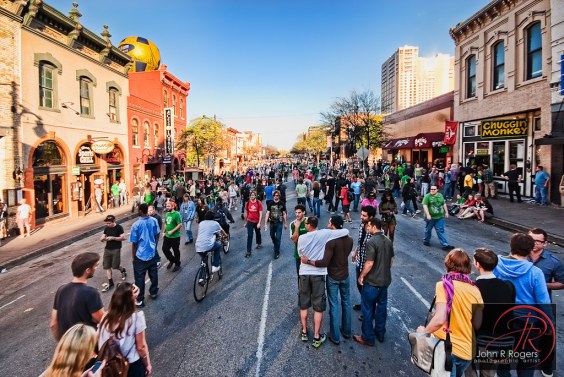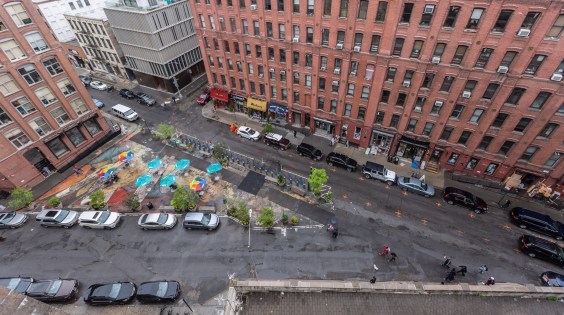A Republican member of Congress told me last week that he recently was in London for the first time in a long while. “Traveling was so much better,” he said. “You can actually get around. That traffic-charging system they’ve got seems to be doing a lot of good.”
London’s system — known formally as congestion charging — started up 10 years ago this Sunday, on February 17, 2003. In the decade since then it has been meticulously monitored, analyzed and debated — perhaps more than any traffic-managing scheme since Moses parted the Red Sea. It has also spawned a raft of charging programs elsewhere, most notably in Stockholm, and, starting last month, in Gothenburg, Sweden’s second city. Of course, an all-out effort to enact a comparable system here, the proposal to toll motor vehicles entering Manhattan south of 60th Street, died in the state legislature five years ago.
Ten years on is a good time to take stock. Let’s have a look.
What It Is: Cars and trucks pay £10 (roughly $15.60) to drive into or within the charging zone between 7 am and 6 pm on weekdays. The zone is London’s commercial and financial hub and, at 8 square miles, rivals Manhattan’s 8.5-square mile Central Business District. Taxis are exempt, as are qualifying low-emission vehicles. Cars registered to zone residents, who account for 2 percent of Greater London’s 7 million people, pay one-tenth the standard charge.
How Drivers Pay: London’s system deploys 1,360 closed-circuit cameras at 348 sites within the charging zone and on its boundaries to record the license plates of vehicles entering and moving within the zone. The plates are continuously matched against a database of monthly accounts, and “spot” payments are made via Internet or at kiosks, drawing down accounts or billing license-plate holders. This cumbersome system arose not only from the absence in the U.K. of electronic toll collection systems such as E-ZPass when the system was launched a decade ago, but also from the decision to charge for car trips entirely within the zone in addition to vehicle entries. A byproduct is the relatively meager net revenue available for transport improvements.
Traffic Outcomes: In its first few years, the London charging scheme was heralded as a solid traffic-buster, with 15-20 percent boosts in auto and bus speeds and 30 percent reductions in congestion delays. Most of those gains appear to have disappeared in recent years, however. Transport for London (TfL), which combines the functions of our NYCDOT and MTA and which created and operates the charging system, attributes the fallback in speeds to other changes in the streetscape and traffic management:
TfL established that the primary reason for the continued reductions to traffic speed, which would otherwise have been unexpected given falling traffic levels, was a substantial increase in interventions that reduced the effective capacity of the road network for general traffic. These interventions ranged widely, including policies to increase road safety, improve the urban realm, and prioritise public transport, pedestrian and cycle traffic, as well as a large-scale increase in road works by utilities and general development activity. (Travel in London, Report 5 [pdf], p. 77)
Travel Outcomes: Without those “interventions,” which include extensive Olympics-related works, travel speeds likely would be a good deal higher than before the congestion charge. In any event, London is enjoying improved travel choice, access, dependability and safety, as my Congressmember friend observed. According to TfL‘s Travel in London, Report 5:
- The London Underground runs 5 percent more train-miles on the Tube, and traveler delays are down around one-third, versus a decade ago (Table 4.3).
- Bus usage reached a 50-year high in 2011, with 30 percent more service and 20 percent less waiting compared to 2000-01 (Table 4.4).
- Bike trips increased 79 percent from 2001 to 2011, after having stagnated between 1993 and 2001 (Table 2.2).
- Travel fatalities and serious injuries were the lowest on record in 2011 (Figure 5.1), although cycling casualties have risen in recent years, perhaps owing to increased cycling (p. 85).
The bus service gains stem from bus fleet expansion and provision of bus lanes, the former financed by congestion charge revenues, the latter enabled by the initial reductions in auto traffic attributable to the charge itself. Here’s how an FHWA team of experts summed up London’s congestion revenues and expenditures for one recent year (2008):
Revenues from the congestion charge were £268 million (US$435 million) in 2008. When accounting for expenses (about 50 percent), the congestion charge generated about £137 million (US$222 million) in the same year, which by law must be spent on transportation in greater London. Of the 2008 net revenues, 82 percent went for bus improvements, 9 percent for roads and bridges, and the remaining 9 percent for road safety, pedestrian and cycling facilities, borough plans, and environmental improvements.
Lessons for NYC: We’ll compare London’s charging scheme with proposals for NYC, including Sam Schwartz’s developing toll plan, in a future post. For now, these differences are worth noting:
- The cost of toll administration, which soaks up roughly 50 percent of congestion charge revenue in London, would consume only around 10 percent here. The difference arises from both E-ZPass and the vast difference in the quantity of tolling points: 348 in London vs. a few dozen to cross into the Manhattan CBD.
- Gains in CBD auto speeds account for just a fraction (less than a quarter) of traveler time savings projected from tolling in New York. The majority of time savings will be on the road and highway network “approaching” or leaving the CBD, and on the city and region’s transit network through improvements financed by the far greater net revenues. Thus, any creep-back of CBD congestion, as London has experienced as it re-allocates road space, should not cancel improved travel times.
- Travel-speed gains from eliminating “toll-shopping,” as the Schwartz plan would do by equalizing tolls on the East River bridges and tunnels (as well as across 60th Street), should also survive any bounce-back in traffic levels.
As for London, ten years on, no one is proposing scrapping or diluting the congestion charge. Motorists pay to drive in that city's congested center, the sky hasn't fallen, and life on the ground is demonstrably safer, healthier, and better.





